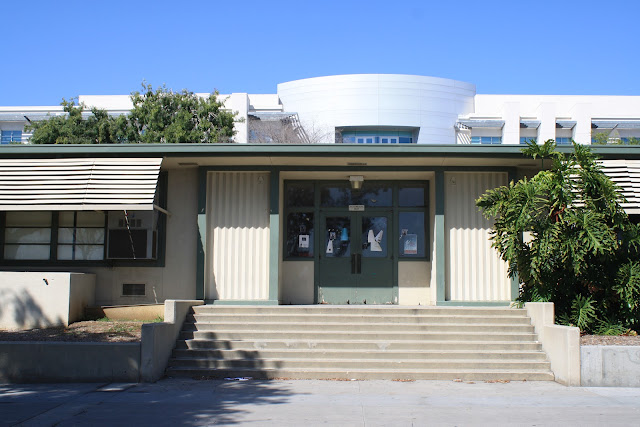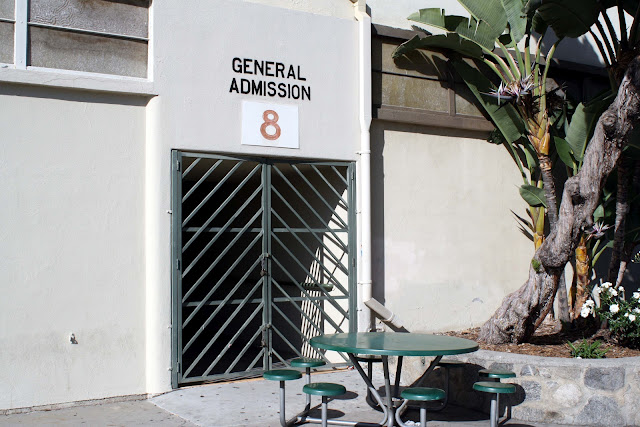This past Saturday afternoon of April 14th I was back on the campus. I sat in a capacity-filled VPAM lecture hall and listened as three historians (Suellen Cheng, former executive director and founding chief curator of the Chinese American Museum; Ron Miller, former president and historian of the National Watercolor Society; Charles Solomon, animation historian and critic) joined artist Milton Quon and curator Sonia Mak to converse about the exhibition and the lives of the five artists.
Impact on Society in Spite of Discriminatory Challenges
The five artists applied their talent to impact a society that contemporaneously excluded them. Mak drew upon the irony that the artists managed to become educated and eke out careers long before the Chinese Exclusion Act was repealed in 1943. Solomon called Tyrus Wong a touchstone in the art of animation because his distinctive style has resonated with new generations of artists in the industry.
Time Marches on the History of East Los Angeles College
Institutions for learning also proliferated after the end of war. East Los Angeles College was a prime example. I decided to take Betty's initiative (could not resist the pun) and learn about the origins of ELAC.
The first junior college established in 1929 was the Los Angeles City College (then called Los Angeles Junior College.) In the Spring of 1945, the Los Angeles School District (later known as LAUSD) approved funds to create a new junior college.
News reports explained that the proposed new school would be established in a "decentralized" location that would be geographically desirable to students. Temporarily established on the campus of Garfield High School about a mile and a half away from the present-day campus, the college was open by October of 1945.
Returning war veterans comprised twenty percent of the male student population. Veterans were now armed in peace-time with education assistance under the G.I. Bill. Chicanos who served by the hundreds of thousands had opportunity for higher education.
Spanish Grazing Land
The land later to become the permanent site of ELAC at Cesar Chavez Avenue (formerly Brooklyn) near Atlantic Boulevard was a part of Antonio Maria Lugo's vast Rancho San Antonio, one of the earliest Spanish land grants in the region bestowed to a California-born soldier of the Spanish army. The area later became Rancho Repetto, named after an Italian, Alessandro Repetto, who also purchased other contiguous parts that today comprise southern Monterey Park and Montebello. Chunks of the Repetto estate were bought in the mid-1880s by five prominent men: Harris Newmark; his nephew Kaspare Cohn; John D. Bicknell, Isaias Hellman, and Stephen M. White. (Newmark and Cohn also founded Montebello; Hellman would later donate parcels of land for the original USC campus; White would later become a U.S. Senator and champion for a free harbor at San Pedro.)
The land at Brooklyn and Atlantic was wilderness during the Spanish and Mexican periods in Alta California. Repetto herded sheep on his land. By the time the land changed hands again, ensuing years it was vacant land at Brooklyn and Atlantic, in contrast to nearby properties of Hellman and his business partners that were rich with oil strikes.
First Graduating Class in the Summer of 1946
The first graduating class of ELAC consisted of two men and one woman. Shown below is a plaque in front of the Rosco C. Ingalls Auditorium. Dr. Ingalls was the first college director of ELAC; he was the director of Los Angeles Junior College for the prior eleven years.
A year had past as East Los Angeles Junior College functioned under crowded conditions at Garfield High School by December, 1946. By then the school district positioned itself to purchase a 35-acre lot from Isaias Hellman. At the same time, the County Board of Supervisors were aiming to acquire 80 acres adjacent for the purpose of building a controversial juvenile hall complex. The community objected, and the juvey hall plan went away.
 |
| The expansive space-hogging stadium parking lot at the northwest corner of campus - the approximate site of the foiled plan for a juvenile hall. |
The new campus was formally opened on January 29, 1948. Several small buildings and eight large buildings were moved from Garfield High School. Four large buildings were acquired from the Santa Ana Army Air Base that was decommissioned after the war ended. The new semester started on February 2nd. The number of instructors in 1945 were 12 to the student population of 117. The count just prior to the new campus was 46 instructors to 1,182 students.
In the Spring, Julian Nava was elected Student Body President, and Mitzi Ishihara won the seat of Vice President.
 |
| From the Los Angeles School Journal 9/22/47 Courtesy of the Seaver Center |
In November, 1949, the ground-breaking for a million-dollar cement stadium took place and was expected to be ready for the following year's football season. An Administration building was proposed in early 1950 but lack of funding led to a suspension of the plans by September. The construction of an auditorium managed to receive funding and was finished in a timely manner by 1951.
 |
| The south face of the auditorium |
1951 was also the starting point of actor Vincent Price's relationship with ELAC. He frequently spoke on campus and at the graduation ceremonies. One of his legacies was his gift of his art collection for which 90 pieces were first deeded in 1957 and has grown to over 9,000 items today.
By the close of 1951, the school district purchased temporary classroom buildings. Those buildings were still in "temporary" use in 1955, but new construction funds had also been approved. Library construction found funding in 1957 - modernization to the Helen Miller Bailey Library began in 2009 and is still ongoing.
The administration of the city colleges underwent re-structuring to separate itself from a K-12 system; in 1967 Governor Ronald Reagan authorized the establishment of a Board of Governors for the California Colleges and changed the official designation of the institution from "junior" to "community" colleges.
By 1969, the Los Angeles Community College District was created with its own Board of Trustees. They approved a library addition and more classroom construction in a projected 10-year plan.
Development of Surrounding Neighborhoods
ELAC's presence brought the development of new houses nearby in East Los Angeles as well as Monterey Park. In December of 1950 the Board of Education asked the City Council of Monterey Park to exclude the college boundaries in the city's bid towards annexation of 400 acres. By 1954, the construction of Atlantic Square shopping center was under way.
It was not until 1976 that voters allowed Monterey Park to achieve annexation, adding 256 acres that included ELAC and the Bella Vista area of East L.A.
Today's Campus
In the new millenium, the campus is a mix of older single story buildings, new construction, multi-story parking structures and open-air parking lots.
The campus outer rim appears very modern with giant lettering:
 |
| Along Collegian Avenue |
 |
| New construction is peeking out from behind the single-story building |
 |
| One of the early new structures done in the 21st century - the Technology Center |
 |
| The Helen Miller Bailey Library has been undergoing modernization |
Weingart Stadium
A lot of school spirit resides on the north side of campus. As with the entire campus it is also in flux with renovations.
 |
| Notice the finish date of Fall 2010 has been pasted over with a new date of Summer 2012. |
 |
| A Springtime reminder of the dissent from last October, 2011 |






















